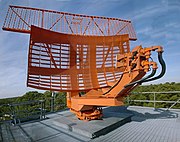History of radio § Broadcasting
Radar
Radar is a radio location method used to
locate and track aircraft, spacecraft, missiles, ships, vehicles, and also to
map weather patterns and terrain. A radar set consists of a transmitter and
receiver. The transmitter emits a narrow beam of radio waves which is swept
around the surrounding space. When the beam strikes a target object, radio
waves are reflected back to the receiver. The direction of the beam reveals the
object's location. Since radio waves travel at a constant speed close to the speed
of light, by measuring the brief time delay between the outgoing pulse and the
received "echo", the range to the target can be calculated. The
targets are often displayed graphically on a map display called a radar screen. Doppler
radar can measure a moving object's velocity, by measuring the change in
frequency of the return radio waves due to the Doppler effect.
Radar sets mainly use high frequencies in the microwave
bands, because these frequencies create strong reflections from objects the
size of vehicles and can be focused into narrow beams with compact antennas. Parabolic
(dish) antennas are widely used. In most radars the transmitting antenna also
serves as the receiving antenna; this is called mono static radar. Radar which
uses separate transmitting and receiving antennas is called bi static radar.
Airport surveillance radar –
In aviation, radar is the main tool of air traffic control. A rotating dish antenna sweeps a vertical
fan-shaped beam of microwaves around the airspace and the radar set shows the
location of aircraft as "blips" of light on a display called a radar
screen. Airport radar operates at 2.7 – 2.9 GHz in the microwave S
band . In large airports the radar image is displayed on multiple
screens in an operations room called the TRACON (Terminal Radar Approach
Control), where air traffic controllers direct
the aircraft by radio to maintain safe aircraft separation.
Secondary
surveillance radar – Aircraft carry radar transponder, transceivers
which when triggered by the incoming radar signal transmit a return microwave
signal. This causes the aircraft to show up more strongly on the radar screen.
The radar which triggers the transponder and receives the return beam, usually
mounted on top of the primary radar dish, is called the secondary
surveillance radar. Since radar cannot measure an aircraft's altitude with any
accuracy, the transponder also transmits back the aircraft's altitude measured
by its altimeter, and an ID number identifying the aircraft, which is
displayed on the radar screen.






Comments
Post a Comment